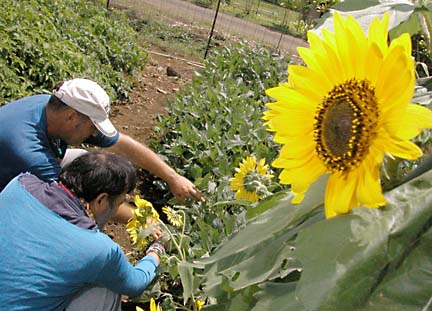
CRAIG T. KOJIMA / CKOJIMA@STARBULLETIN.COM
Site coordinator David Hyler, left, worked with a patient in the sunflower patch this week.
Isle mentally ill
enjoy mall program
Mentally ill patients who used to spend days sleeping in their rooms are learning and socializing at the mall.
Instead of stores, restaurants and theaters, this mall features school, work, recreational and recovery activities to help improve the patients' lives when they leave the Hawaii State Hospital in Kaneohe.
"What's different about this program is, patients love it -- and that's why we're here: patient care," said Jackie Lee, director of the Psychosocial and Rehabilitation Treatment Mall.
One patient who has been in the hospital eight years without participating in anything is going to classes smiling, Lee said.
It's easy to refuse classes in the units, where patients can go back to their rooms and sleep, she said. They still can refuse, but they must go to a "refusal room" where there's nothing to do, she said. "In a few minutes they're back to class.
"We are putting patients first all the time," she added. "Hopefully this will get us out from under (a U.S. Department of Justice lawsuit)."
U.S. Magistrate Kevin Chang, monitoring court-ordered hospital improvements, highly praised the program in a recent report to U.S. Chief Judge David Ezra.
The mall, which is open weekdays from 9 a.m. to 2:30 p.m., began June 9 with 155 patients participating from six units. An acute unit with 18 to 20 patients has its own minimall.
"What's really good about it is, it provides a more normalizing routine at the hospital," said Kim Meyer, rehabilitation director. "Before, it was like never getting out of the living room where you reside."
Security was tightened in the administration building, and many offices relocated to accommodate classes. Activities also are held in other buildings and at work sites.
"We have to get everybody to own it, that it's everybody's mall," said Paul Guggenheim, hospital administrator, acknowledging that the program does not have total staff support.
"Closing the units, the main focus of the hospital for 80 to 100 years, is a paradigm shift."
He said the program affects the whole hospital because "every piece of space imaginable" is being used. "It's got to be driven by creativity, things out of the box. It's changing as we go along."
Patients arrive from their units at 9 a.m., go to home rooms for a head count, then attend two classes or activities before lunch and two after lunch.
A five-bed sick bay was set up in the administration building, Meyer said, explaining, "The goal is to have everything all inclusive so there is no reason to go back (to the units)."
He said meaningful activities are emphasized that patients can continue after leaving the hospital, including personal care, health and nutrition, vocational and social skills, and recreational activities such as tennis, volleyball, exercise and tai chi.
Among classes are adult literacy, math and reading, health education, goal-setting and skills to think more clearly. Patients can meditate or relax in a "mood room" painted blue with stars and moons on the walls and black lighting.
Catherine Davis, the hospital's patient advocate for 10 years, greets the patients every morning and says the mall is "the best thing that ever happened" to them. "Every single one we've asked says it's good. It's doing wonders for the patients. It's amazing."
She said a record was set recently with no grievances from patients for six days.
"I can't believe it myself. I don't think we've ever gone one to two days at the most, and that is pretty rare."
Lee, Duke Jumawan, psychiatric technician who manages the mall, and nurse Grace Pakele feel they have accomplished a lot in a short time but said they are working to make it better.
Meyer said the mall is scheduled in 12-week quarters, each usually followed with a one-week break. Many staff meetings are held to discuss concerns and improvements, and the patient council meets with Guggenheim so there is a lot of interaction, Meyer said.
He said the program "affected a long routine" for some staff members, but they're "coming on board more" as they see changes in the patients.
He noted some surprising results. For instance, three patients walked away from the hospital in the first two weeks but were escorted back in about 20 minutes, he said. No one has left since, he said.
Some patients who would not participate in any programs before are going to classes, and some who were the most difficult are no trouble at all, he said.
Many patients have capabilities that "rise to the occasion" in the mall setting, Meyer said. "Sitting in the unit, there is no occasion to rise to."
He said vocational activities are planned "to get people on their feet in the community" with new or improved skills. Patients earn tokens for their work that they can redeem in a hospital store.
They are learning to do external car detailing, which they say is great because they are outside getting exercise. They work in the hospital's Kau Kau Cafe and do tasks around the hospital.
They are also clearing a jungle next to the hospital to raise vegetables, fruit and flowers for lei-making and floral arrangements. An open market will be held at the hospital when there is enough produce, Meyer said.
A 38-year-old woman who has been in the hospital two years said she really likes the treatment mall and working in the garden. "I can get away from everything. I look forward to it and learn a lot, insight into working with others."
She said she has learned to manage her mood swings and illness and how to talk to people, which she hopes will help her get a job in a grocery store after leaving the hospital.
